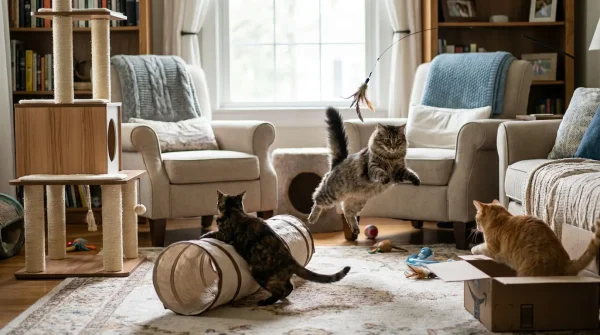Common Cat Behavior Problems: Understanding and Solving Feline Behavioral Issues

Cats are beloved companions known for their independence and unique personalities, but like any pet, they can develop behavior problems that challenge even the most patient owners. Understanding the root causes of these behaviors is crucial for maintaining a harmonious household and ensuring your feline friend’s wellbeing.
From inappropriate urination to aggressive behavior, cat behavior problems can stem from various sources including medical issues, environmental stressors, or natural instincts that aren’t being properly channeled. This comprehensive guide explores the most common feline behavior problems and provides practical solutions to help you and your cat live together peacefully.
1. Inappropriate Urination and Spraying
One of the most frustrating cat behavior problems is inappropriate urination outside the litter box. This issue affects approximately 10% of cats and is a leading reason why cats are surrendered to shelters. Understanding the difference between urination and spraying is crucial for addressing the problem effectively.
Causes:
- Medical issues: Urinary tract infections, kidney disease, diabetes, or arthritis can cause cats to avoid the litter box
- Litter box problems: Dirty litter, wrong litter type, box too small, or poor location
- Stress and anxiety: Changes in environment, new pets, or household stress
- Marking territory: Unneutered males marking territory, or stress-induced marking
Solutions:
- Consult your veterinarian to rule out medical causes first
- Maintain clean litter boxes (scoop daily, change weekly)
- Provide one litter box per cat plus one extra
- Use unscented, clumping litter that your cat prefers
- Place boxes in quiet, accessible locations
- Reduce stress through environmental enrichment
- Use synthetic feline pheromone diffusers
2. Aggression Toward People or Other Pets
Aggressive behavior in cats can manifest as biting, scratching, hissing, or swatting. This behavior problem requires immediate attention to prevent injury and maintain household harmony.

Types of Aggression:
- Play aggression: Common in young cats who haven’t learned bite inhibition
- Fear aggression: Defensive behavior when cats feel threatened
- Petting-induced aggression: Sudden biting during petting sessions
- Redirected aggression: Aggression directed at someone other than the actual trigger
- Territorial aggression: Directed at new pets or people entering the cat’s territory
Solutions:
- Never punish aggressive behavior physically (escalates fear and aggression)
- Identify triggers and avoid or gradually desensitize
- Provide appropriate outlets for play and hunting instincts
- Use interactive toys for play sessions (not hands)
- Learn to recognize early warning signs (dilated pupils, tail lashing, flattened ears)
- For severe cases, consult a veterinary behaviorist
3. Destructive Scratching
Scratching is a natural and necessary feline behavior, but when cats target furniture, carpets, or walls, it becomes problematic. Cats scratch to mark territory, stretch muscles, shed old claw sheaths, and express emotions.
Solutions:
- Provide appropriate scratching posts: Vertical and horizontal options in different materials (sisal, cardboard, carpet)
- Strategic placement: Place posts near sleeping areas and entry points
- Make furniture unappealing: Use double-sided sticky tape, aluminum foil, or plastic covers
- Attract to appropriate surfaces: Use catnip or悬挂 toys on scratching posts
- Regular nail trims: Every 2-4 weeks to reduce damage
- Consider nail caps: Soft plastic caps that blunt claws without declawing
Never declaw your cat as a solution – this is an amputation of the last toe bone and can cause long-term physical and behavioral problems.
4. Excessive Vocalization
While some cats are naturally more talkative than others, excessive meowing, yowling, or crying can indicate underlying issues and disrupt household peace.
Common Causes:
- Medical issues: Hyperthyroidism, high blood pressure, cognitive dysfunction in senior cats
- Attention-seeking behavior: Learned behavior that gets a response
- Breeding behavior: Intact cats vocalizing to attract mates
- Aging changes: Cognitive decline or sensory loss in senior cats
- Stress or anxiety: Environmental changes or disruption to routine
Solutions:
- First, rule out medical causes with a veterinary exam
- Avoid reinforcing the behavior – don’t respond to attention-seeking meows
- Reward quiet behavior with treats and attention
- Provide environmental enrichment to prevent boredom
- Maintain consistent daily routines
- For senior cats, provide extra comfort and cognitive support
- Consider spaying/neutering if intact
5. Nocturnal Activity and Nighttime Disruption
Cats are naturally crepuscular (most active at dawn and dusk), but some cats take this to extremes, running, playing, and vocalizing throughout the night, disrupting their owners’ sleep.

Solutions:
- Increase daytime activity: Interactive play sessions, especially in the evening
- Feed before bedtime: A small meal can induce sleepiness
- Provide bedtime routine: Consistent schedule signals sleep time
- Ignore nighttime attention-seeking: Responding reinforces the behavior
- Create a comfortable sleeping area: Cozy bed in a quiet location
- Provide nighttime entertainment: Puzzle feeders or quiet toys
- Consider separate sleeping areas: If necessary, to ensure everyone sleeps
6. Fabric Chewing and Pica
Some cats develop compulsive behaviors like chewing or eating non-food items such as wool, plastic, or fabric. This condition, known as pica, can be dangerous if cats ingest materials.
Potential Causes:
- Genetic predisposition: Particularly common in Siamese and Burmese breeds
- Early weaning: Cats weaned too early may suckle on fabrics
- Nutritional deficiencies: Anemia or other deficiencies
- Stress or anxiety: Compulsive behavior as coping mechanism
- Boredom: Lack of environmental enrichment
Solutions:
- Consult veterinarian to rule out medical causes
- Blood work to check for anemia or nutritional issues
- Increase environmental enrichment and mental stimulation
- Provide safe alternatives like cat grass or chew toys
- Use taste deterrents on dangerous items (bitter apple spray)
- Store dangerous items out of reach
- Consider anxiety medication for severe cases under veterinary guidance
When to Seek Professional Help
While many cat behavior problems can be resolved with patience and environmental modifications, some situations require professional intervention:
- Sudden behavior changes (may indicate medical issues)
- Severe aggression causing injury
- Persistent problems despite trying multiple solutions
- Signs of extreme anxiety or distress
- Compulsive behaviors like excessive grooming or self-harm
Consider consulting:
- Veterinarian: Rule out medical causes first
- Veterinary behaviorist: Specialists in animal behavior with medical training
- Certified cat behavior consultant: Experts in feline behavior modification
Conclusion
Cat behavior problems can be challenging, but they’re rarely insurmountable. The key to success is understanding that most problematic behaviors are either natural feline behaviors expressed inappropriately or responses to stress, medical issues, or environmental factors.
By approaching behavior problems with patience, consistency, and a willingness to see things from your cat’s perspective, you can strengthen your bond while creating a more peaceful home environment. Remember that punishment is never effective with cats and often worsens problems by increasing fear and anxiety.
Instead, focus on positive reinforcement, environmental enrichment, meeting your cat’s natural needs for play, scratching, and territory, and working with veterinary professionals when needed. With time and the right approach, most cats can overcome behavior problems and become the loving, well-adjusted companions they’re meant to be.





